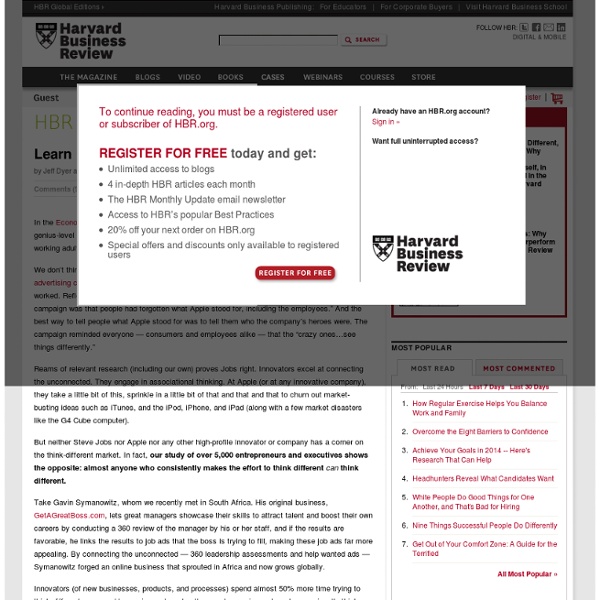Thinking Methods: Creative Problem Solving
They further divided the six stages into three phases, as follows: 1. Exploring the Challenge (Objective Finding, Fact Finding, and Problem Finding), Generating Ideas (Idea Finding), and Preparing for Action (Solution Finding and Acceptance Finding). Description: Since the arrival of the now classical Osborn-Parnes structure, any number of academic and business entities have re-sorted and renamed the stages and phases of what we now call the Creative Problem Solving Process (CPS).
The Sixteen Personality Types - High-Level
ISTJ - The Duty Fulfiller Serious and quiet, interested in security and peaceful living. Extremely thorough, responsible, and dependable. Well-developed powers of concentration. Usually interested in supporting and promoting traditions and establishments.
7 Ways to Cultivate Your Creativity [Slide Show]: Scientific American Slideshows
Email Order now to receive an issue of Scientific American MIND , risk-free, with no obligation to buy. » Get your risk-free issue today....[ More ] Give a Gift & Get a Gift - Free!
Realistic Lateral Thinking Puzzles
Lateral Thinking Puzzles, unlike most puzzles, are inexact. In a sense, they are a hybrid between puzzles and storytelling. In each puzzle, some clues to a scenario are given, but the clues don't tell the full story. Your job is to fill in the details and complete the story.
Crafter (role variant)
Crafters are tactical operators, concrete in speech and utilitarian in action. In social situations, they are directive and reserved.[2] Crafters are masters at using tools of every type—artistic, technological, martial. Although they are introverts, they are authoritarian in their interactions with others and can be forceful at influencing people. They focus on accomplishing tasks efficiently and skillfully. To master the tool of their interest, Crafters require a certain degree of seclusion in which to practice. The result is often a virtuosity that other types find difficult to match.[1]
Everyday Creativity
The tattoo artists throughout Russia's prison system have never had lessons in painting technique (nor, apparently, hygiene training). They don't have ink and tools at their disposal. And yet they create entire murals on one another's chests and backs: onion-domed cathedrals, intricate cobwebs, chilly grim reapers.
How Great Entrepreneurs Think
What distinguishes great entrepreneurs? Discussions of entrepreneurial psychology typically focus on creativity, tolerance for risk, and the desire for achievement—enviable traits that, unfortunately, are not very teachable. So Saras Sarasvathy, a professor at the University of Virginia's Darden School of Business, set out to determine how expert entrepreneurs think, with the goal of transferring that knowledge to aspiring founders. While still a graduate student at Carnegie Mellon, Sarasvathy—with the guidance of her thesis supervisor, the Nobel laureate Herbert Simon—embarked on an audacious project: to eavesdrop on the thinking of the country's most successful entrepreneurs as they grappled with business problems. She required that her subjects have at least 15 years of entrepreneurial experience, have started multiple companies—both successes and failures—and have taken at least one company public.
Protector (role variant)
The Protector Guardian is one of the 16 role variants of the Keirsey Temperament Sorter,[1] a self-assessed personality questionnaire designed to help people better understand themselves. David Keirsey originally described the Protector role variant; however, a brief summary of the personality types described by Isabel Myers contributed to its development. Protectors correlate with the ISFJ Myers-Briggs type.[2] Protectors are observant, cooperative, informative, and attentive. They are greatly concerned with the security of others and they often find assisting the downtrodden or people with disabilities to be satisfying.
Use Image Searches Like a Thesaurus to Overcome Your Creative Blocks
Are there empirical studies about how to be creative? Isn't it completely subjective and personal? yup. There are entire peer-reviewed journals committed to the subject. I'm writing my dissertation on the topic.



